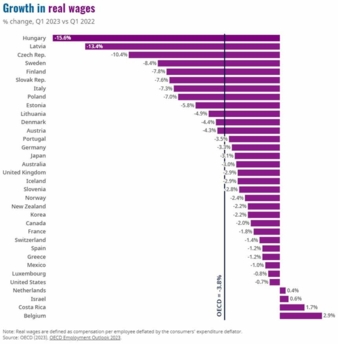30/08/2023 – OECD Study
Latest trends in jobs and wages: Stabilized labor markets
According to the OECD study “Employment Outlook 2023” pub, labor markets remain very tight in most member countries although the number of vacant positions per job seeker has declined in many markets.
Employment has stabilized at a level slightly higher than before the COVID crisis, while unemployment rates across the OECD remain historically low. Labor market participation has increased as well, with fewer working-age people inactive than before the COVID-19 crisis, and the average hours worked per employed person are above or just below pre-crisis levels in most countries.
In parallel labor markets have pushed up nominal wages, but less so than inflation, leading to a fall in real wages in almost all industries and OECD countries. In the first quarter of 2023, despite the pick-up in nominal wages, real annual wage growth was negative in 30 of the 34 countries with available data, with an average decline of 3.8% (US: +0,7%).
The real value of statutory minimum wages has been preserved thanks to regular adaptation to inflation in many OECD countries. This is particularly important as high inflation weighs heavily on low-income households and on overall consumption climate.





